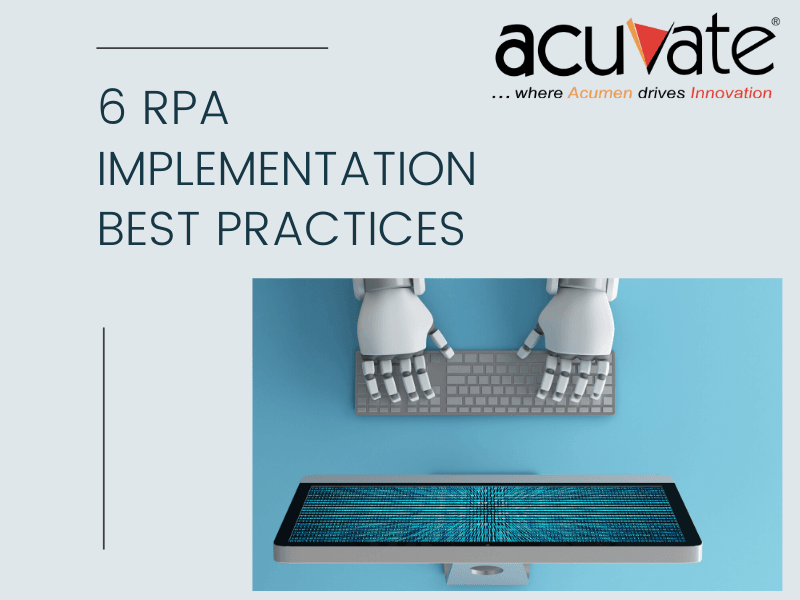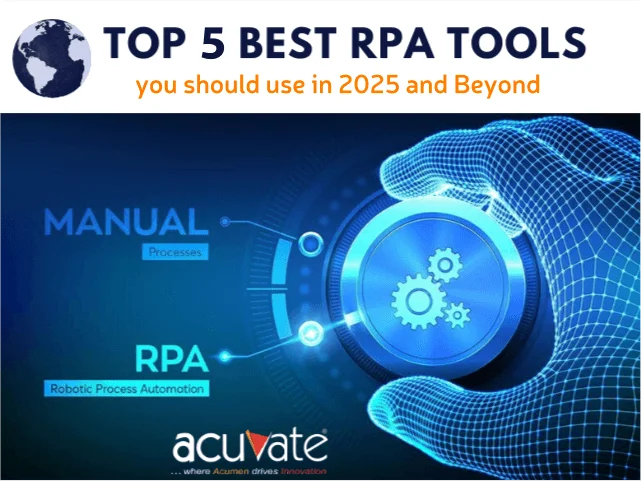Application leaders are struggling to modernize legacy applications owing to the complexity and cost of making system updates. Consequently, organizations turn to manual processes and workarounds — leading to increased costs and processing errors. Enterprises can now eliminate the manual processes between systems by RPA.
The host of benefits that Robotic Process Automation (RPA) offers, be it saving time, productivity, bringing in cost efficiency or giving companies a competitive edge, is making it a technology that enterprises are rearing to implement. According to Colan Infotech, The RPA and Hyperautomation market together is growing rapidly at a CAGR of 23.9% between 2024 and 2033.
By the end of 2025, RPA is expected to be worth $22 Billion – Forrester
One of the reasons for its widespread appeal is the fact that RPA is a cost-effective and non-invasive technology. It does not demand any changes to the organization’s existing infrastructure. Instead, the software integrates itself as a layer that sits on top of the IT architecture and works seamlessly with all the applications.
RPA is a blend of user interface recognition technologies and workflow execution. It can mimic the mouse clicks and keystrokes of a human using a screen and keyboard to drive applications and execute structured work.
This quick-to-integrate nature of RPA is what makes it capable of being implemented in a matter of weeks, showing results quickly.
According to McKinsey, the revenue in the first year upon RPA implementation shows a growth of 30 – 200% in the company.
In this article, we give you the low-down on the best practices to follow when implementing RPA in your organization.
6 RPA Implementation Best Practices
1. Select right processes to automate
One of the primary considerations when embarking on your RPA journey, is the selection of the right function or process to automate. Examine your business activities and user interaction data to unveil the right tasks contributing the most benefit when automated.
Beginning RPA implementation with a business process that is most conducive for automation helps see the expanse of RPA’s capabilities, while at the same time showing results quickly.
Quick pointers to identify the right tasks:
- Stable and Mature Processes – A stable, mature and well documented processes is a perfect launchpad for pilots. Trying to automate an unstructured or ever changing process can be resource and cost intensive.
- Rule-based processes – RPA can mimic actions for processes that are repeatable and tend to follow a defined set of rules. This is because RPA bots are programmed with rules and as the complexity of rules increase, it becomes difficult to track results.
- High-Volume and error-prone processes – Automate a high-volume process that has the potential to reduce a significant amount of human effort and are often prone to manual errors.
Here is a quick checklist:

Learn More: How Does RPA Look in Action
2. Plan wisely and build center of excellence (CoE)
Supporting the identification of the right processes, organizations must lay down a crystal-clear set of the objectives mapping to business outcomes.
Countering the resistance to new technology adoption, a strategic implementation and change management plan in place, might mitigate challenges and facilitate employee adoption.
Another way to effectively prepare for the change is by establishing a center of excellence right from the start.
Formulate a CoE team that includes experts from cross-functional departments playing a key role like RPA champions, change managers, service support, analysts, etc. This not only helps adoption but also avoids deviations from the objectives defined.
3. Implement RPA in a collaborative environment
When implementing RPA, remember that it is not just the IT team that must be involved. Although IT plays a crucial role in handling the RPA application post implementation, companies must draw upon the expertise of the end-users as well.
Hence, instead of working in silos, RPA is best implemented as a team, spanning across all the departments that will be impacted by the new technology.
Right when planning the RPA implementation, enterprises must consider getting stakeholders from the concerned departments to pitch-in with ideas and feedback. This information will prove to be extremely useful in driving the digital change in the right direction.
4. Provide training and structured guidance to everyone involved
RPA is a disruptive technology as it tends to have an impact on business and ramifications across departments. In order to ensure that it is perceived as a beneficial implementation as opposed to just another technology experiment, it is important to offer structured guidance to everyone who is associated with the project.
Providing appropriate training to all the associated employees helps create a bevy of digital workers in the organization. Ensure that you train everyone, right from the senior, managerial pool, right down to the junior employees. Effectively explain to them the need for RPA in the company, how and where it will make a difference to their responsibilities and the potential benefits of implementing RPA.
One way to effectively train all the employees is to first identify a niche pool of eventual trainers, provide structured guidance to them on the RPA implementation and then, let them train the rest of the employees on what to expect on the automation journey.
5. Select a pilot project and partner with experts
Although RPA is relatively quick to implement, it is a complex and disruptive technology that can be intimidating for a lot of organizations that are new to it. Hence, in order to test the waters, companies can consider selecting a pilot project to implement it on.
Ensure that the goal and the expected results from the pilot project are clearly defined in order to effectively measure the impact of the RPA implementation. Companies can also consider running a live pilot regularly to study a random selection of the RPA use case and evaluate its results.
Also have a plan B in place in case there is a need for you to reassess and re-work the RPA tool after deploying it and moving it to production.
6. Promote RPA sandbox to foster experimentation
Often application leaders in IT are considered as RPA police. The hesitance of IT leaders to let the business experiment with different scripts to automate their jobs is killing the opportunity of anticipating possible chances of failure in the future. Remember, real innovation will come from those experiencing the pain of inefficient processes in their workday.
Avoid creating bottlenecks and pain points for the future by enabling a sandbox for testing by the business leaders. Optimize the performance of the quick-win opportunities identified before scaling up automation to a relatively complex task.
Stratify the overall portfolio of business stakeholder demand to create your hyper-automation roadmap. Once chalked down and after successful implementation, enable real-time testing with the help of concerned stakeholders to bestow the ablest of RPA automation into eager hands.
Learn more: RPA Tools To Watch For in 2020 and Beyond
Wrapping Up
Enterprises have, so far, paid a huge price for the patchwork of legacy application enhancements and automation. With the advent of RPA, automation has democratized integration leading to widespread adoption.
Ensuring efficacy and business agility, RPA is certainly a store to check in the path of digital excellence. It helps in meeting the need but requires strategy, guardrails and governance.
The combination of RPA with process mining, ingestion engines, analytics, user experience, and machine learning will facilitate the creation of a hyper-automated AI journey that mimics the capabilities of humans. However, the synthesis of all these isn’t an easy job. It certainly needs an expert intervention.
In spite of its non-invasive nature, RPA still requires a great amount of expertise and the right resources to be implemented correctly. If your organization lacks the needed resources, it is best to work with a capable implementation partner such as Acuvate to effectively implement RPA in the company.
Acuvate helps implement RPA as a part of your intelligent automation journey, helping you bring in cost and time efficiencies in the organization while improving both customer and employee experience.
If you’d like to learn more about this topic, please feel free to get in touch with one of our experts for a personalized consultation.



